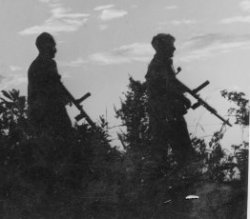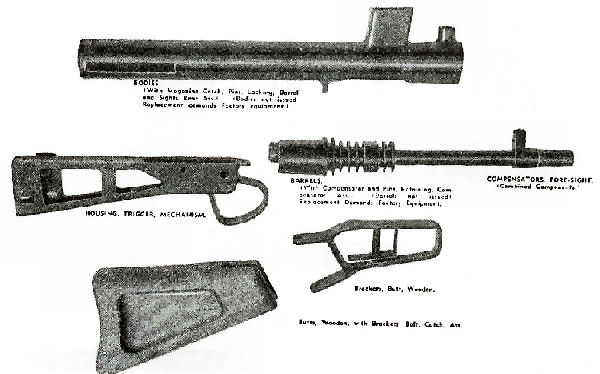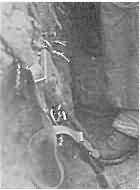Owen Caliber 9mm Machine Carbine And Training ManualThe Owen fired a 9mm parabellum, 115 gr bullet at 700 rpm from a 33-round detachable box at 1250 fps muzzle velocity, giving only 400 ft-lbmuzzle energy and slowing down fast. It was a toss-up as to whether either the Chinese Burp gun or the Owen would penetrateheavy winter clothing at much over a hundred yards. Still, simple in design, with loose fitting parts, rugged and deadly in close quarter action, the Owen was a weapon made for the Aussie Digger warrior.

Machine Carbine, 9mm Owen, Mark 1
Rugged Australian designed and manufactured weapon |
The Owen went into production about mid 1941, with about 50,000 produced by 1945. Although quite large and bulky, the Owen was a first-class gun and very popular with those who used it, for it stood up well to the hard conditions of jungle fighting and stoppages were remarkably rare. | 
| Its two outstanding features were the top mounted magazine -- a feature rarely seen on submachine-guns since the Villar Perosa -- and the provision of a separate bolt compartment inside the receiver so that the bolt was isolated from its retracting handle by a small bulkhead, through which passed the small diameter bolt. This ensured that dirt and mud did not jam the bolt and it was highly successful, although expensive in terms of space.
| Two other unusual mechanical features: the ejector is built into the magazine rather than into the gun body, and the barrel is rapidly removable by pulling up on a spring-loaded plunger just ahead of the magazine housing. The latter feature is necessary since, due to the method of assembly and construction, the gun can only be dismantled by removing the barel and then taking out the bolt and return spring in a forward direction.
|  |
Comments by ron cashman; December 05, 1999 Hello Bert, wandering through your list of British weapons and noticed the absence of perhaps the best close combat weapon of its time, the Owen gun. (One shown here against bunker as my platoon prepared for a patrol on Hill 355, Little Gibraltar). Being made and used by Australians it was not well known, theBrits would give a case of Stens for one;and our American comrades working alongside us felt thesame once they saw its capability. It was a back-yard invention of about 1942 used in the manyAustralian conflicts from WW2 through to Vietnam. | 
| The Owen didn't freeze up in the winter either; the working parts were so simple and loose fitting that just cradling it in your arms when laying up on an ambush was sufficient to keep it working.I did hear the odd complaint that the bullets weren't powerful enough to penetrate the thickChinese winter clothing. All I can say about that is, nobody I ever fired at stood up for another burst; or kept running as the case may have been. Re your Burp-gun story (BK: email tale unfavorably comparing the P41 cartridge with the parabellum), one of our lads was hit with 29 slugs from onewhen the Nog decided not to worry about his health; he lived.No vital organsof course, but gee he was heavy to carry home! | Comments by 'Snow' Dicker; February 23, 2000
I remember the Owen and a few of its faults, like bumping the butt on the ground or catching the bolt knob on your webbing fired the gun and caused a few casualties in the ranks, till their little nasties were overcome. Also we found that the fire power and shape of the round-nosed bullet, against people wearing quilted uniforms at about 100 metres was not a good combination. Although it caused a lot of feathers to fly around, it did not do the job asked of it. In the jungle against people wearing wet shirts, it was a different story. I kept my Lee Enfield with me at all times.
Comment by sherro; Monday, June 26, 19100 at 02:30:02I was quite interested to see the writeup on the 9mm OMC (Owen Machine Carbine). We carried them for a very short time in Vietnam as the issue weapon for forward scouts (called point scouts in the US Army). After seeing first hand the (lack of positive) results of two people shooting at two VC at 20' range and one of our own accidentally shot in the back with one (2in penetration), as a forward scout I point blank refused to carry one under threat of charges. Worn weaponry and ammo made in 1943 was a very poor combination for combat. I was much happier carrying an SLR (Australian FAL) with a full mag of tracer for serious social work. In Korea I certainly would have carried an SMLE .303 over an Owen if given the choice. Bullet placement, not volume of fire is everything. Uncle Sherro. |
Causes of the Korean Tragedy ... Failure of Leadership, Intelligence and Preparation
The Foundations of Freedom are the Courage of Ordinary People and Quality of our Arms
|


